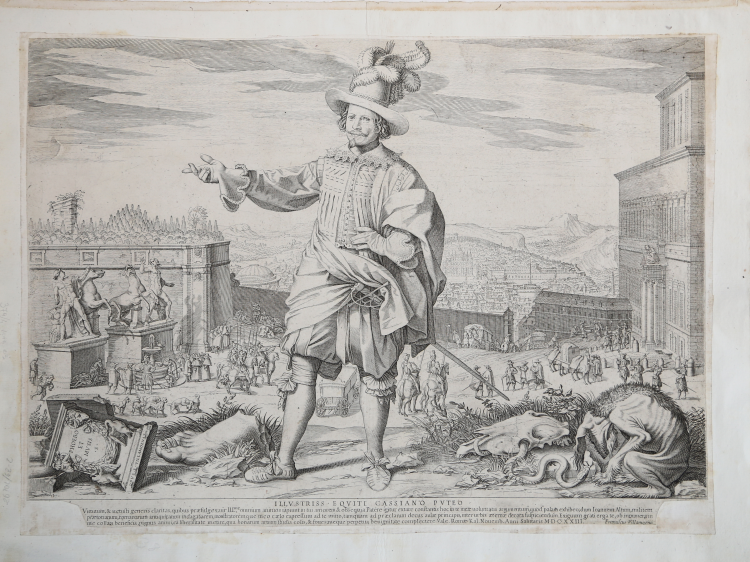



| Reference: | S42687 |
| Author | Francesco VILLAMENA |
| Year: | 1623 |
| Printed: | Rome |
| Measures: | 530 x 385 mm |


| Reference: | S42687 |
| Author | Francesco VILLAMENA |
| Year: | 1623 |
| Printed: | Rome |
| Measures: | 530 x 385 mm |
Engraving, 1623. On the base of the antique altar at the left: OPVS.F.VILLAMOENA.F In the margin: ILLVSTRISS, EQVITI CASSIANO PVTEO/Virtutum, et vetusti generis claritas, quibus praefulges; vir ILL.me omnium animos rapiunt in tui amorem et obsequia. Patere igitur extare constantus hoc in te meae voluntatis argumentum, quod palam exhibeo; dum Ioannem Altum, militem / praetorianum, romanarum antiqui- tatum indagatorem, monstratoremque meo caelo expressum ad te mitto, tamquam ad praeclarum decus aulae principis, inter urbis aeternae decora suspiciendum. Exiguum grati erga te ob innumera in / me collata beneficia, pignus animi, ea liberalitate metire, qua bonarum artium studia colis, et foves; meque perpetua benignitate complectere Vale. Romae Kal. Nonemb. Anni Salutaris M.D.C.XXIII. Franciscus Villamoena // Cum privilegio / Sum. Pont.
Example in the second final state, published by Carlo Losi in 1773. Printed on contemporary laid paper, applied on antique paper, lower left and right corner cut, occasional foxing, otherwise excellent condition.
The Losi imprint was displayed on the lower left “Romae apud/ Carolum Losi/ Anno 1773”; on lower right corner there was the inscription “Superiorum/ permissu”
The full-length portrait is of the Swiss Guardsman Ioannes Altus, also known as Johann Alten, Johann Alt and Giovanni Alto. Altus is depicted in military costume, with a plumed hat and a sword in the Piazza del Quirinale. His right arm is lifted and he gestures to the viewer to look towards the antiquities behind him. He is surrounded by sculpture fragments, a skull, a snake and a starving animal in the foreground. In the background, figures mill around the square and the city is visible in the distance. The engraving is a 1773 reprint by the publisher and print dealer Carlo Losi from a 1623 work by Francesco Villamena.
“He is gesturing like a guide pointing out some aspect of the antiquities of the city. The text in the margin describes him as one who investigates the antiquities and shows them to people. To the left a great marble foot is placed next to his right foot, and further left a fallen altar is inscribed 'PHOEBO / ET / MVSIS / .s.'. On the right a snake curls through a horse's skull, flicking its tongue at a mangy dog (or perhaps a wolf?) next to a tomb slab inscribed D M (Diis Manibus). The serpent, perhaps a symbol of destructive time, seems victorious, and the grandeur of Rome has to be discovered amidst the bustle of ordinary life. The modern life of the city is not always salubrious, as is shown by the packs of dogs, beggars and people urinating in corners. The choice of the Piazza del Quirinale as the setting was presumably motivated not only by the view of Rome and the presence of great antiquities such as the Horse Tamers (there seems to be a umorous echo of one of them in Johann Alten's stance) and the remains of the Temple of Sarapis in the Colonna garden behind; in addition, the Quirinal Palace, seen on the right, had by this time become a principal residence of the popes and therefore a suitable place for a member of the Swiss Guard to be seen. St Peter's and the Vatican are given particular prominence in the background.” (Bury, The Print in Italy, n. I, p. 17)
References:
Arrigoni-Bertarelli 2709; Bury, n. I, p. 17; Kühn-Hattenhauer 1979, pp. 137-40; Grelle in Ficacci 1989, pp. 138-40, no. 7; Griffiths 1993, p. 258, no. 161 1926-5-11-43.
Francesco VILLAMENA (Assisi, 1564 - Roma, 7 Luglio 1624)
|
Italian engraver. According to tradition, he was a pupil of Cornelis Cort, whose engravings he copied, and was associated in his youth with Agostino Carracci. He made few original engravings but reproduced designs of artists including Raphael, Paolo Veronese, Federico Barocci, Girolamo Muziano and Giulio Romano. His output also included frontispieces and book illustrations. Closely related to such northern late adherents of Mannerism as Hendrick Goltzius and Jacques Bellange, he employed an elegant and expressive calligraphic style with perfect control of the burin. In addition to religious and historical subjects, he executed portraits, notably a series of genre figures (Rome, Gab. N. Stampe). In 1594 he executed a series of engravings illustrating scenes from the Life of St Francis. His oeuvre comprised at least one hundred plates.
|
Francesco VILLAMENA (Assisi, 1564 - Roma, 7 Luglio 1624)
|
Italian engraver. According to tradition, he was a pupil of Cornelis Cort, whose engravings he copied, and was associated in his youth with Agostino Carracci. He made few original engravings but reproduced designs of artists including Raphael, Paolo Veronese, Federico Barocci, Girolamo Muziano and Giulio Romano. His output also included frontispieces and book illustrations. Closely related to such northern late adherents of Mannerism as Hendrick Goltzius and Jacques Bellange, he employed an elegant and expressive calligraphic style with perfect control of the burin. In addition to religious and historical subjects, he executed portraits, notably a series of genre figures (Rome, Gab. N. Stampe). In 1594 he executed a series of engravings illustrating scenes from the Life of St Francis. His oeuvre comprised at least one hundred plates.
|